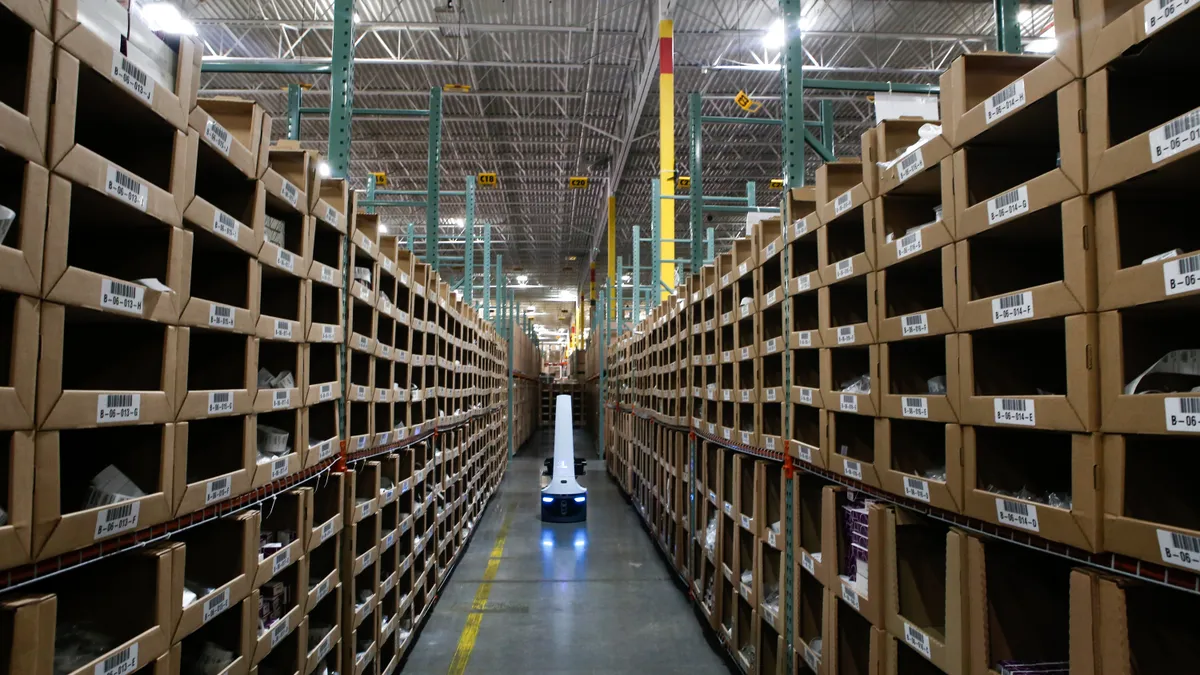CHICAGO — The average warehouse worker spends only 20% of his or her shift performing the activity that generates revenue for a business: picking. The remaining 80% is spent walking in the warehouse, Karen Leavitt, the CMO at Locus Robotics, said at ProMat 2019 in Chicago.
The "Amazon effect" has driven consumers to expect shipments in two days or fewer, amplifying the imbalance of time, said Sudha Chandrasekharan, VP of product management at HighJump.
In the past, most items in a warehouse were stored in large containers or packages and stacked on a series of pallets. The growth of e-commerce has led to an explosion in small parcel deliveries and therefore more piece picking. More labor is needed to achieve the same level of productivity with this method of picking. "You actually need a small army of people to fulfill orders," Chandrasekharan said.
Some facilities adopted a band-aid solution of bigger carts to pick and fulfill small orders, keeping employees in the aisle for longer. But this came with its own challenges."Now she's lugging around a cart that by the end, it's 150 to 200 pounds," Leavitt said. "We're putting greater burden on the worker herself."
The larger carts also made fulfillment less nimble. If employees are in the aisles for longer then products don't leave the aisle until later. This requires a customer to place their orders earlier if they require fulfillment that day, Leavitt said.
Under the large cart strategy, consumer demand and warehouse operations seemed to move in opposite directions. Consumers wanted their goods faster, but warehouses, in an effort to cope with increasing demand for e-commerce orders, attempted solutions that in fact made them slower.
As e-commerce continues to grow, the warehouse of the future will need to be prepared to handle increased orders in an increasingly agile way.
The solution according to Leavitt and Chandrasekharan: technology. The speakers outlined three examples of warehouse technology solutions to achieve faster fulfillment and flexible supply chains: warehouse management systems (WMS), voice technology and robotics.
A WMS can facilitate multi-ordered picking, thereby improving employee productivity. Implementation of WMS has proven challenging for many companies due to time and cost. Selecting a WMS can take several months, not to mention the implementation afterward. As of last year, about one-third of warehouses didn't have a WMS.
In studies by HighJump, voice technology increased productivity by up to 35% by eliminating a worker's need to refer back to a document and instead verbally hear instructions for the location of objects to pick. As an additional benefit, voice technology reduced training time, turnover and safety incidents among workers, according to HighJump.
Chandrasekharan and Leavitt acknowledged robotics often gets a reputation as a buzzword, but the technology can have significant positive impacts on time reduction in fulfillment. Robots picking items cut down on "wasted walking time" for human labor, Leavitt said.
Robots should be collaborative and work alongside humans, not replace them altogether, she suggested. The division of tasks plays to the strengths and maximizes the productivity of each.
"The expectation here is that the robot's not going to do the job all on its own," she said. "We have the transportation and decision-making being done by the robot, and we have manual dexterity and analytical thinking being done by the human."
The combination of WMS, voice technology and robotics enable a faster and more efficient warehouse of the future, Chandrasekharan and Leavitt said. In reality, that warehouse may not be that far off. E-commerce is already exploding, and the so-called Amazon effect of fast shipping has taken hold.
The two speakers said next-generation technologies like voice picking and robots are viable solutions in today's warehouse. "The right solutions for the supply chain challenges that we see are actually opportunities for businesses to differentiate," Chandrasekharan said.














